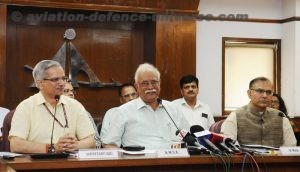- Helicopter operations under the Scheme are limited to Priority Areas only
- Selected Airline Operators (SAO) get sharper teeth
New Delhi. 29 August 2017. The Minister of Civil Aviation P Ashok Gajapathi Raju recently announced that the process for bidding for the second round of the Regional Connectivity Scheme – UDAN has begun and the thrust will be on improving connectivity to priority areas like the North East, Jammu & Kashmir, Uttarakhand, Himachal Pradesh , Andaman & Nicobar Islands and Lakshdweep by introducing more operational flexibility and promoting helicopter operations. The Minister informed that the changes in the second round of UDAN had been brought in after extensive consultations with stakeholders over the last four months.

The Regional Connectivity Scheme UDAN is a key component of the National Civil Aviation Policy (NCAP) which was released by the Ministry of Civil Aviation on 15th June 2016. UDAN was launched in October, 2016 with the prime objective to facilitate / stimulate regional air connectivity by making it affordable for the masses.
Among the important changes that are being effected, routes with stage length less than 150 Kms will now be permitted for operations as RCS Routes through fixed wing aircraft. This is aimed at providing enhanced connectivity and ease the formation of networks under the Scheme. While exclusivity of operations will continue to be applicable for a period of 3 years, Selected Airline Operators (SAO) can issue No-Objection Certificate (NOC) to other airline operators willing to operate on the respective RCS Route .This will ensure there is no supply constraint on RCS Routes. To provide more flexibility to Selected Airline Operators (SAO), the maximum number of flights with VGF have been increased to 14 for Priority Areas. Further, the SAOs can anytime increase the number of flights on RCS Routes to any number. Also, minimum performance specifications will no longer be applicable on Non-RCS Routes.
 Helicopter operations under the Scheme are limited to Priority Areas only. To encourage this, the VGF Caps for helicopters has been increased and 10% of the estimated annual inflows in the RCF will be earmarked for helicopter operations . Further, all 13 passenger seats for helicopters will be considered as RCS Seats and VGF will be provided accordingly. The methodology for computing flight duration for helicopters has also been revised based on the recommendation of Expert Committee.
Helicopter operations under the Scheme are limited to Priority Areas only. To encourage this, the VGF Caps for helicopters has been increased and 10% of the estimated annual inflows in the RCF will be earmarked for helicopter operations . Further, all 13 passenger seats for helicopters will be considered as RCS Seats and VGF will be provided accordingly. The methodology for computing flight duration for helicopters has also been revised based on the recommendation of Expert Committee.
Several changes have been brought in to improve connectivity to priority areas. Priority RCS Route is being defined as an RCS Route in which at least one of the airports – origin or destination – is an RCS Airport located in a Priority Area, and the said RCS Airport satisfies the definition of Underserved Airport or Unserved Airport under the Scheme.. An Underserved Airport for Priority Areas will mean any airport which is not an Unserved Airport and there are no more than fourteen (14) scheduled commercial flight departures per week as per the latest flight schedule published by the DGCA on its website. Additional category of aircrafts will be permitted for operations on Priority RCS Routes. Proposals for these areas will be prioritized. There will be Enhanced VGF Caps for operations through Category-1 A and Category-1 Fixed-wing aircraft for Priority RCS Routes. Also, helicopter operations under the Scheme are being allowed only on Priority RCS Routes.
Also speaking on the occasion MoS Jayant Sinha said that the first round of UDAN has been very successful. Private airlines have placed orders for a large number of aircrafts fly on RCS routes. A total of 29 unserved / under served airports will be connected under the first round of the Regional Connectivity Scheme – UDAN by September end this year. This includes 8 that have already been connected and 21 soon to be connected. The remaining 14 airports out of the 43 unserved / under served airports that were to be connected under the first round, are under process of upgradation. Sinha further said that with its thrust on connecting Priority Areas and the its newly introduced flexibility features, the second round of UDAN will be an improvement over the first round .




























































































































